All beekeepers are faced with the phenomenon of swarming bees. It occurs for many reasons. Some experienced beekeepers argue that swarming can be prevented. But, if it really happened, then the departing swarm needs to be caught, and for this, the beekeeper’s help is a special box - a roev.
In this article we will talk about how to make a royal hand with your own hands from various scrap materials.
Table of contents
What is roevna?
A bee roach (trap) - a lightweight box or basket for catching and transporting an departing swarm.
What should be the trap?
- Roomy enough for large swarms.
- Have a light weight and strength.
- With air circulation.
- Have a comfortable shape.
- In order to fix the trap in various hard-to-reach places, there must be comfortable hooks or a strap.
- The cover should not crush the bees.
Today, Butlerov’s construction is popular among beekeepers. It consists of a frame with hoops attached to it. They press the wire mesh. The upper part consists of a folding, tight-fitting cover. Side hooks for hanging. Trap size:
- with a diameter of 30-35 cm;
- 40-45 cm high.
Equipped with tools: scoop and wood picker.
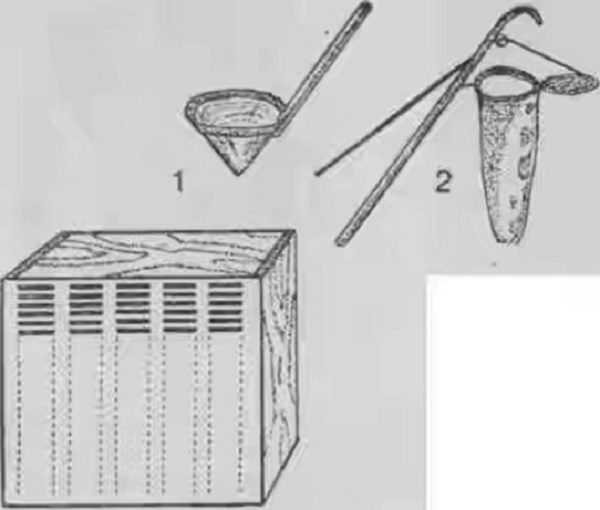
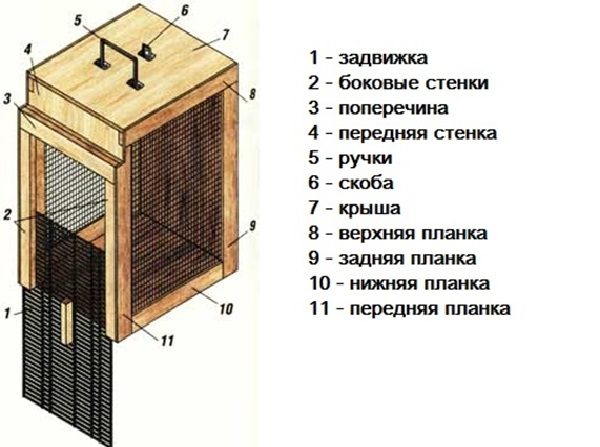
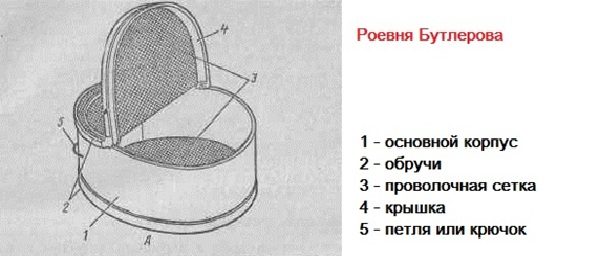
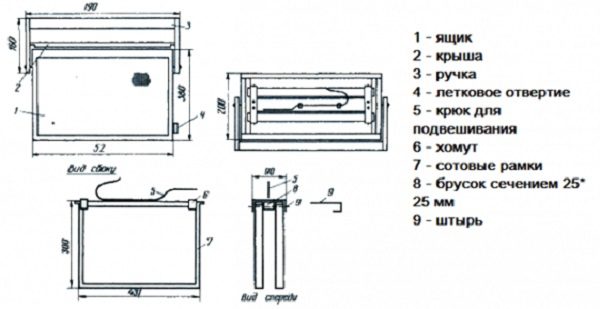
Plywood and polystyrene foam are perfect for making roevni.
How to make a roevna for bees with your own hands?
Since it is best to make a roev of light materials, plywood is most suitable for manufacturing.
She has many virtues. Cheap stuff. Lightweight. Made of natural wood, so it is an environmentally friendly material, which means that the bees will feel comfortable in it.It has durability. Available in several types and varieties, differing in cost and thickness, and even moisture resistance.
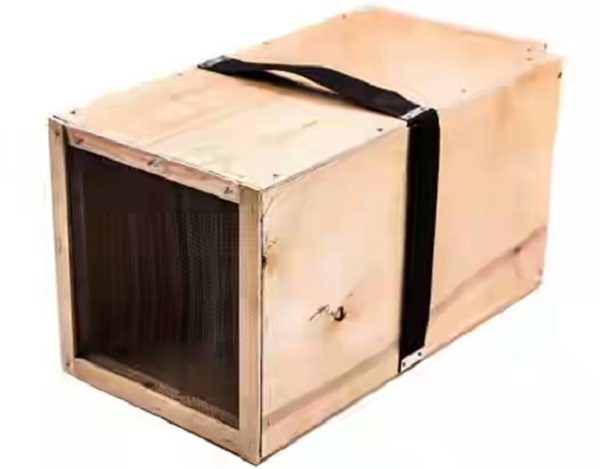
It is worth considering in more detail how to make a roev for bees with your own hands according to drawings made of plywood. For manufacturing is used.
- Metal grid.
- Dies made of wood or extruded plates.
- Mosquito net.
- Plywood.
- Cardboard.
- Waterproof glue.
- Scissors.
- Tools for wood.
Instructions for making
1 way:
- Dimensions:
• bottom - 35 * 45 cm;
• side walls (2) - 30 * 45 cm;
• cover - 20 * 45 cm;
• front wall - 35 * 20 cm. - First cut parts.
- Glue together all the details.
- Make the entrance on the side wall of 1 * 8 cm
- Do the air change frame.
- Tightly put a grid on it, secure with shoe nails.
- Churn 4 walls in a box.
- Attach the hanger on the inside of the back and front wall. The bottom of the mow. There will be frames with honeycombs.
- Attach the cover to the bolts. Make a hole in the lid. Obtyanut his mesh.
- Attach the hooks from the sides. They are needed for mounting traps in the trees.
2 way:
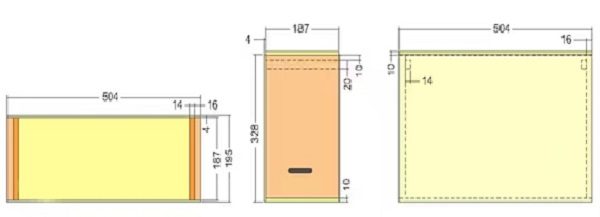
- Cut the side walls.
- The frame, for the manufacture of suitable rail 4 cm wide.
- In frame make folds to establish a framework.
- On the front wall cut out the entrance 1 * 1 cm.
- Assemble the side and end walls.
- Install cover. Top up with a tin.
- In the ready roev put dry, at least five frames.
- To attract bees to rub it with wax or propolis, or mint, or citrus peels.
- To attach handles for easy transportation.
- To increase the service life you can paint and paint, but this must be done in advance in order to have time to erode all odors.
Roevna can be made in another form.
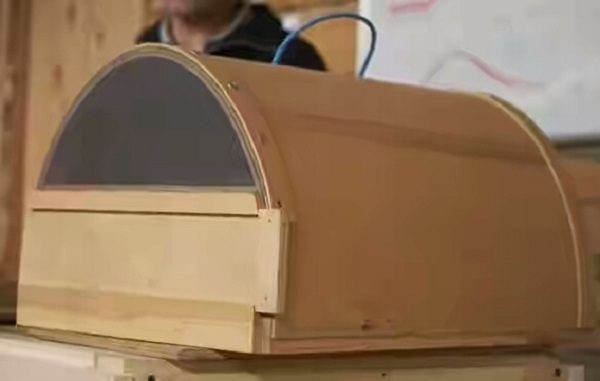
And a visual video, how to make a match.
Polystyrene Foam
Styrofoam lighter than plywood. Eco-friendly material. It does not start mold. Moisture and airtight, but condensation forms. Requires additional ventilation holes in the hive. High thermal conductivity. Lasting. Do not gnaw mice, bees and birds do not peck. These are all pluses of it. The downside is that it is easily damaged mechanically and is destroyed by the rays of the sun.
It is done quickly and the materials for its production are inexpensive.
Consists of parts:
- bottom;
- roof;
- 4 walls.
To make a return, you should use the following materials:
- stationery knife;
- sheets of polystyrene foam (30 mm);
- ruler;
- pencil;
- Master glue, PVA or liquid nails;
- self-tapping screws;
- screwdriver.
Dimensions.
- side walls (2) - 51 * 35 cm;
- front and back - 30-25 cm;
- bottom - 51-36 cm;
- roof - 52-36 cm.
In size cut parts and glue together. For strength, fasten with screws.
You may also be interested in:
- How to make a trap for bees do it yourself
- Medicinal properties and contraindications propolis.
- Beeswax application in folk medicine and cosmetology.
- How to use royal jelly.
In order for the lid to close tightly, you need to make the notches:
- depth 0.5 cm;
- width 3 cm
Letok cut in the form of a small square. A mesh is attached to it during transport.
Attach a sturdy tape to the base. With the help of her roevna installed on the branches.
Advantages of the design:
- fast and cheap production;
- is lightweight.
The disadvantage is loose material therefore, it is necessary to work with it carefully so that the branches do not damage the case.
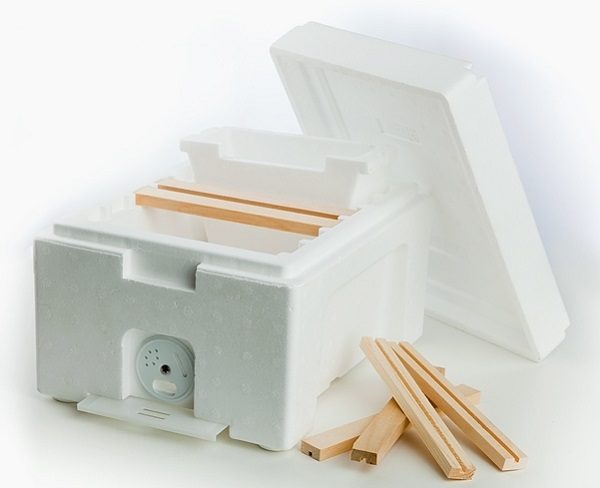
How to choose a place to install?
Install the swarm should be in advance, about a week for two swarming. The trap is best fixed on spruce and pine trees. Look at the tree, which will be 100 meters from the apiary or the edge of the forest. The optimal height is 5-6 m. To the branches, the swarm is attached with a wire.
Check the trap every other week. If, when checking out, you find out that a family has already settled in it, cover the entrance and transfer it to the hive prepared in advance. Reinstall the trap in the same place. To attract bees, rub it with attractive smells. In stores you can buy special products "Apira" or "Apimil".
It is not a big deal to make a roevna with your own hands, and it doesn't take much time either. On long winter evenings, frames and hives can also be made. Having made all these devices for work at the apiary on your own, you will be assured of their quality and thus deliver comfortable conditions to the bees, and they in turn will thank you for an excellent harvest of tasty and healthy honey.
Finally, a video on how to assemble a swarm of roy.

Twice they themselves tried to make a round match, it does not work!
Plywood breaks. Tell me how to gently bend? Or give up the idea with a round swill?
Oksana, you can steam the plywood before bending. Then should not break.
My dad has a royal handicraft made from plywood too. True, I did not see him install it. When a swarm takes off and piles at a convenient place for them, he brushes them away from the bird in the box. The downside is that the apiary is far from being able to track down the bees and the swarm fly away. In such cases, really, a trap on a tree would help.